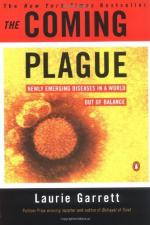
|
| Name: _________________________ | Period: ___________________ |
This test consists of 5 multiple choice questions, 5 short answer questions, and 10 short essay questions.
Multiple Choice Questions
1. The epidemics of what disease increased due to the Aswan High Dam inhibiting the natural fluctuations in water height?
(a) Malaria.
(b) Yellow fever.
(c) Swine Flu.
(d) Schistosomiasis.
2. In what year did the CDC call the first International AIDS Conference?
(a) 1991.
(b) 1996.
(c) 2002.
(d) 1985.
3. An epidemic of what disease proved that the United States was in rough shape and in need of timely vaccinations?
(a) Yellow fever.
(b) Measles.
(c) Dengue fever.
(d) Schistosomiasis.
4. What is a virus that is duplicated in a host cell using the reverse transcriptase enzyme to produce DNA from its RNA genome?
(a) Retrovirus.
(b) Polyvirus.
(c) Omnivirus.
(d) Slow virus.
5. The WHO created the Declaration of Alma-Ata which sought to unite the world in a push to create healthy living conditions for everyone by what year?
(a) 2100.
(b) 2000.
(c) 1995.
(d) 2050.
Short Answer Questions
1. In a small village in Uganda, young women began becoming ill following sex with a traveling salesman and the disease was dubbed ______________.
2. What refers to a process by which thermal radiation is absorbed by atmospheric greenhouse gases and then re-radiated in all directions?
3. With the first signs of the AIDS epidemic, the CDC quickly created a quiet division to work on the problem, while who traveled to see San Fransisco first hand in Chapter 11: "Hatari: Vinidogodogo"?
4. What was the second social epidemic noted by the WHO?
5. Some bacteria began using spore formation to defend against antibiotics, and this worked well against ___________.
Short Essay Questions
1. What are retroviruses and oncogenes? What was discovered about them in Chapter 8: "Revolution"?
2. What impact did AIDS have in India?
3. How did drug use perpetuate the spread of AIDS?
4. What was the impact of tuberculosis in America? What improved conditions?
5. How does the author describe the correlation between tampons and outbreaks of TSS in Chapter 12?
6. How does the author correlate the development of urban centers to the growth of disease in Chapter 9: "Microbe Magnets"?
7. How did many nations respond to the AIDS epidemic?
8. When was the hantavirus first discovered? What was the source of the epidemics?
9. What three social epidemics related to the biological epidemic of AIDS are observed in Chapter 14: "Thirdworldization"?
10. How does the author describe the outbreak of Lyme disease? How did human interaction impact the disease?
|
This section contains 908 words (approx. 4 pages at 300 words per page) |

|




